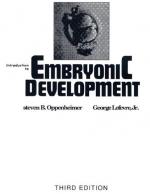|
This section contains 994 words (approx. 4 pages at 300 words per page) |

|
Human pregnancy is a very inefficient process. In fact, beyond the fact that normally it produces only a single fetus, 50% of the fertilized ovocytes are lost before implantation, and a further 15% are lost within the 10 weeks of embryonal development. Because of this, several events crucial for the conceptus survival take place at this time. Early development can be grouped into four periods: (1) Early preimplantation embryo (until 8 cells) where a symmetric and asynchronic cellular division of toti-potential cells takes place. (2) Late preimplantation embryo characterized by cellular differentiation and embryo hatching. (3) Implantation, where trophoblast invasion of the maternal deciduas allows the survival by means of establishment of maternal-fetal connections.
Although fertilization results in the union of maternal and paternal gametes, zygotic gene activity is not required until the blastula stage. In the egg, there exist maternally derived genes...
|
This section contains 994 words (approx. 4 pages at 300 words per page) |

|


